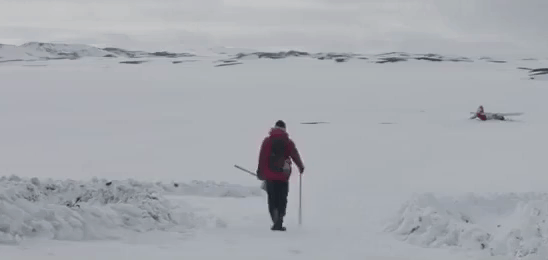Mads Mikkelsen is faultless in the gracefully told survival drama Arctic

Stranded and desperate, Mads Mikkelsen is put to the test in the survival in the wilderness drama Arctic. His performance is faultless and the film is gracefully told, writes critic Luke Buckmaster.
Every contemporary snow-covered survival in the wilderness movie exists in the shadow of director Joe Carnahan’s The Grey. This magnificent 2011 film transcends the high/low art divide by audaciously juggling explorations of masculinity with various kinds of Liam Neeson badassery – wrestling wolves and taping crushed up booze bottles to his knuckles, for instance, while reciting a melancholic poem written by his late father.
If the protagonist of Arctic, a strong-willed fellow named Overgård (Mads Mikkelsen), has seen The Grey, he might consider himself lucky. The plane he has crashed in the middle of ice-covered nowhere has been fairly well preserved, after all, with a not-dissimilar amount of space as that afforded by a tiny house; in this era of the housing affordability crisis one cannot be too fussy. Also, there are no ravenous beasts – with the possible exception of a snitchy neighbourhood polar bear – salivating at the sight of his frosty face.
Director Joe Penna opens Arctic with a long shot of Overgård, surrounded by vast white expanse, digging into the snow with a shovel. Why is he here and what is he doing? Penna (who co-wrote the film with Ryan Morrison) cuts to a birds eye image capturing his work: three huge carved out letters reading “SOS.” A reveal of this kind might not herald any great feat of storytelling ingenuity, but it is a significant early moment – establishing a film of elegant compositions and primarily visual intent.

Wordless revelations are strewn throughout Arctic, from the very first to the very last moment. It is refreshing not just to watch an atmospherically tense film that operates in slavishly visual terms, but also one that wasn’t shot in jangly handheld compositions – the proliferation of which has had a pernicious effect on visual style in film and television. The images of cinematographer Tómas Örn Tómasson are clean, uncluttered and handsome, with modestly imaginative framing.
Arctic is one of those films with a “style” designed to reduce the very perception of style in the first place. Penna obviously intended a transparent space, encouraging the viewer’s disappearance into this universe rather drawing attention to methods of construction. He provides, as they say, a ‘window into the world’, with a rather unadorned view, given this environment is so sparse and the drama so closely aligned to one person’s behaviour. The narrative rests on a small number of big decisions. One of these, which will not be elaborated upon here, concerns whether Overgård should remain at his lonely outpost or risk it by trekking across an unforgiving landscape. Let’s just say he has his reasons.
Mads Mikkelsen – who recently starred in Netflix’s execrable action movie Polar, a smutty piece of adolescent-minded filth – makes the protagonist’s choices resonate and carries the film well. It is a faultless performance, but by god the man was cold well before he set foot on the snow. In Arctic his ‘I eat puppies for breakfast’ visage can be explained by the intensity of the setting rather than some innate, barely repressed bastardy, which is the case in several of Mikkelsen’s roles – including as the titular character in the TV show Hannibal.
In Arctic dramatic payoffs are few and far between and backstory is minimal. Its primary qualities are experiential, prioritising setting and circumstance over story. There is a purity in this kind of straightforward approach, particularly in an age of visual freneticism, even if the director scores no points for originality or innovation. To his credit, the film is always gracefully told.

















